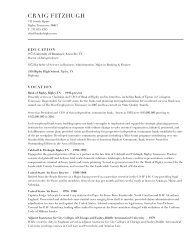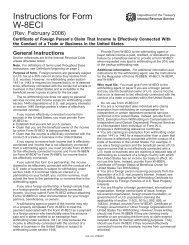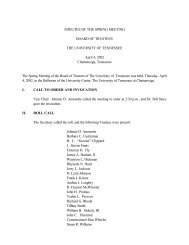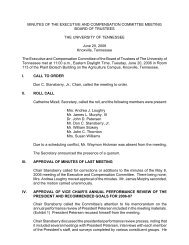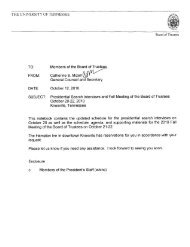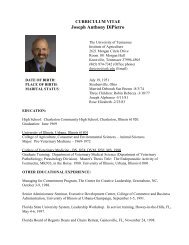Finance and Administration - Board of Trustees - The University of ...
Finance and Administration - Board of Trustees - The University of ...
Finance and Administration - Board of Trustees - The University of ...
You also want an ePaper? Increase the reach of your titles
YUMPU automatically turns print PDFs into web optimized ePapers that Google loves.
<strong>Finance</strong> <strong>and</strong> <strong>Administration</strong> Committee - V. Annual Report <strong>of</strong> the Treasurer, 2011 - InformationReport <strong>of</strong> the Treasurer 2011Brief History <strong>of</strong> the <strong>University</strong> <strong>of</strong> Tennessee3<strong>The</strong> <strong>University</strong> <strong>of</strong> Tennessee is one <strong>of</strong> the nation’s oldestinstitutions <strong>of</strong> higher education, in operation since 1794.Two years before Tennessee achieved statehood in 1796, thelegislature <strong>of</strong> the Southwest Territory—which later becameTennessee—granted a charter to Blount College, named inhonor <strong>of</strong> the territorial governor, William Blount. Locatedin Knoxville near today’s downtown area, Blount Collegewas nonsectarian, which was unusual for an institution <strong>of</strong>higher education at that time. <strong>The</strong> university has remainednondenominational <strong>and</strong> is believed to be the oldest suchinstitution west <strong>of</strong> the Appalachian Divide. Blount Collegewas all male, typical for colleges <strong>of</strong> the late 18th century, arestriction that remained in force for almost a century untilthe first women students were admitted in 1892.In 1807 the state legislature changed the name <strong>of</strong> BlountCollege to East Tennessee College, <strong>and</strong> in 1826 the 40-acretract known as “the Hill” became part <strong>of</strong> its campus. <strong>The</strong>name <strong>of</strong> the school changed again in 1840 to East Tennessee<strong>University</strong>. But 21 years later, the Civil War forced theuniversity to close, <strong>and</strong> its buildings were used as a hospitalfor Confederate troops, then later occupied by Union soldiers.with the public university to become its fourth primary campus.<strong>The</strong> <strong>University</strong> <strong>of</strong> Tennessee Space Institute, a graduateeducation <strong>and</strong> research center near Tullahoma, was establishedin 1964.Three statewide units <strong>of</strong> the university—the Institute <strong>of</strong>Agriculture, the Institute for Public Service, <strong>and</strong> the Division <strong>of</strong>Continuing Education—extend the university beyond its variouscampuses to serve the entire state.<strong>The</strong> administration <strong>of</strong> the university is headquartered inKnoxville, where the <strong>of</strong>fices <strong>of</strong> the president <strong>and</strong> the central staffare located. A chancellor directs each primary campus.Traditionally, Tennessee’s governors <strong>and</strong> members <strong>of</strong> the statelegislature have shown active interest in the development <strong>of</strong> the<strong>University</strong> <strong>of</strong> Tennessee by providing the support it needs tomeet the increasing educational, research, <strong>and</strong> service needs <strong>of</strong>the people <strong>of</strong> Tennessee. As a result, many university programshave earned both national <strong>and</strong> global recognition.When the war ended, East Tennessee <strong>University</strong> reopened, <strong>and</strong>in 1869 the state legislature selected the university as the state’sfederal l<strong>and</strong>-grant institution under the Morrill Act <strong>of</strong> 1862. Tocomply with the terms <strong>of</strong> the act, ETU broadened its <strong>of</strong>feringsto include agricultural, engineering, <strong>and</strong> military science courses.Ten years later, East Tennessee <strong>University</strong> was chosen by thelegislature to be the state university <strong>of</strong> Tennessee, <strong>and</strong> its namewas changed to the <strong>University</strong> <strong>of</strong> Tennessee. <strong>The</strong> universitypledged itself to the service <strong>and</strong> interest <strong>of</strong> the entire state,<strong>and</strong> the state pledged its name <strong>and</strong> reputation to the university,promising the institution a vital role in the progress <strong>of</strong> the state.Today, the university serves the people <strong>of</strong> Tennessee fromlocations across the state. <strong>The</strong> medical campus, founded inNashville <strong>and</strong> acquired by the university in 1879, was moved toMemphis in 1911. <strong>The</strong> Martin campus, established in 1900 as aprivate institution, became part <strong>of</strong> the <strong>University</strong> <strong>of</strong> Tennesseein 1927. In 1969 the private <strong>University</strong> <strong>of</strong> Chattanooga mergedContentsLetter from the Treasurer 2Auditor’s Opinion Letter 3Management’s Discussion <strong>and</strong> Analysis 4Statement <strong>of</strong> Net Assets 9Statement <strong>of</strong> Revenues, Expenses, <strong>and</strong>Changes in Net Assets 10Statement <strong>of</strong> Cash Flows 11Notes to the Financial Statements 12Required Supplementary InformationSchedule <strong>of</strong> Funding Progress 375-Year Summary 3833







